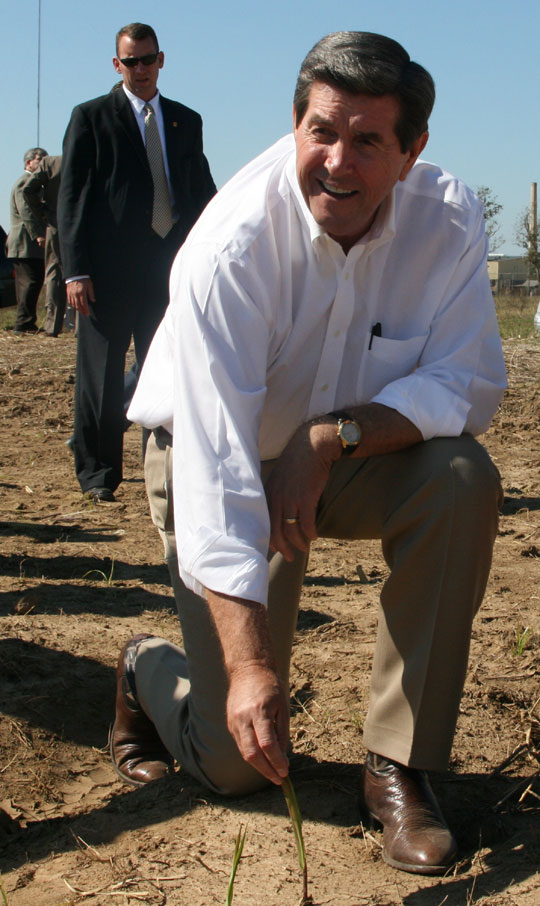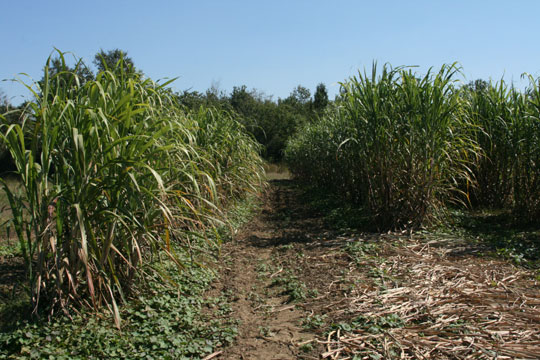Alabama Sugarcane Biofuel Could Mean Profits For North Escambia, Power At Your Home
October 22, 2008
A project that could eventually turn thousands of acres of sugarcane into jet fuel for the Air Force officially got underway Tuesday in Atmore, and that project could one day have a significant impact here in North Escambia with everything from jobs, income for farmers and electricity for your home.
The 100 acre test field near Atmore’s Holman Prison will determine if sugarcane can be grown in this area in a quantity and quality sufficient for the Amyris Company to one day construct a $500 million plant somewhere near Atmore, Amyris CEO John Milo said.
That would, of course, have great impact on the Atmore area, with benefits likely to spill over into Florida.
 “I think this is something we have there that could benefit both states,” Alabama Governor Bob Riley told NorthEscambia.com in an exclusive interview. “We just don’t know for sure how this is going to go, but we feel like this is going to be big. What will work here in this field in Atmore will work for farmers in Northwest Florida.”
“I think this is something we have there that could benefit both states,” Alabama Governor Bob Riley told NorthEscambia.com in an exclusive interview. “We just don’t know for sure how this is going to go, but we feel like this is going to be big. What will work here in this field in Atmore will work for farmers in Northwest Florida.”
Milo tells us that if all goes well the first year with the 100 acre test field, we can expect to see about 1,000 acres planted in two years and 10,000 acres of sugarcane in three years. By the time year three ends, Amyris will have invested a half billion dollars in a biofuel plant in the Atmore area.
Farmers within 25 miles of that plant would be able to sell sugarcane to the company. Why the 25 mile limit? Sugarcane juice begins to ferment on its own shortly after being harvest, so it must quickly reach the plant.
“If that 25 miles includes Florida, you will see thousands of acres planted in Florida,” Milo said. “The whole idea is to first start here in Alabama, and then perhaps build another plant in Louisiana and one in the Florida Panhandle.”
“I look forward to seeing how this might impact agriculture in Escambia and Santa Rosa counties,” said Libbie Johnson from the Escambia County (FL) Extension Office. “We are always looking for ways to keep agriculture a viable industry in our farm communities in Escambia and Santa Rosa counties.”
Seth Hammett, Alabama’s speaker of the house and board member for PowerSouth, said that rising fuel costs are making it easy for PowerSouth to look for alternative fuels. He said that if the sugarcane biofuel plant becomes a reality in South Alabama, PowerSouth and Amyris are already talking.
Hammett said PowerSouth is looking at purchasing the pulp byproduct from the sugarcane to fuel electric turbines for providing power to member electric cooperatives. PowerSouth supplies electricity to cooperatives including Escambia River Electric Cooperative that serves customers in portions of Escambia and Santa Rosa counties.
The biggest problem North Escambia farmers would have with growing sugarcane, Johnson said, would be the investment in all new equipment. None of their existing tractor implements or harvesters would work for planting or gathering the cane.
Sugarcane is planted in fields with “beds” that are six feet wide. A furrow (a long straight hole) is dug, and stalks are laid out end to end. The plants sprout from the “joints” in each piece of cane. The plants sprout in the fall, grow slowly during the winter, and then reach up to 20 feet by the following fall before being cut for harvest. Without specialized equipment, Johnson said it is a very labor intensive process.
Pictured above: A small sugarcane field in North Escambia behind the Davisville Community Church. This cane was planted about a year ago. Pictured above left: Riley will the first official Alabama sugarcane sprout that could one day become jet fuel. NorthEscambia.com photos, click to enlarge.




Comments